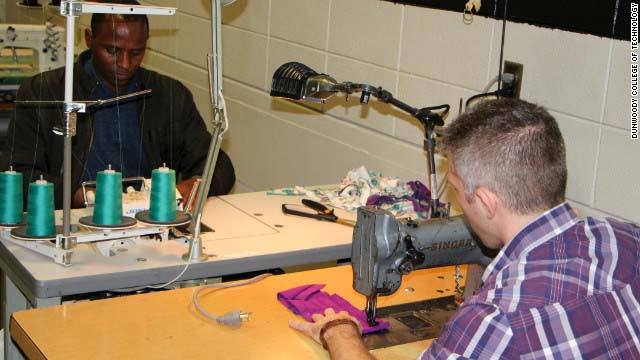

Do you like to sew? I've been sewing since my foot could reach the pedal on my grandmother's singer sewing machine. It was a lost art that has returned in a bad economy.
There are many reasons why people sew - to be creative, to earn money, its therapeutic, because other members of their family have sewn for generations, the cost of store-bought clothes is not affordable, etc. As a Jewish women, my ancestors, going back to the 19th century, were tailors. My father was a pattern designed for a famous men's clothing manufacturer in NYC. I remember my grandmother using an old fashioned Singer sewing machine to make things and do repairs. She was married to a tailor. I still sew to create things I can't find in stores, such as the bedding set and window arrangements above, after envisioning this fabric and design. As to the next generation - my 3 daughters - none of them can sew and have no interest. Alas the gene is lost.


We often talk about the "fabric of reality" and the "patterns of its design" which goes to Sacred Geometry.
There is the metaphor of Grandmother Spider Woman forever spinning that connects everything in the web (matrix) of our time and reality.
Then there are Goddesses Who Weave and Spin.
In the article below I connect with the words "birth" and "genesis" because that is what the fabric (tapestry) of reality is all about.

Students learn industrial cutting and sewing in a training program
organized by a coalition of businesses and industry partners.
'Dying trade' revived in job creation effort CNN - March 3, 2013
By day, Scott Loeser works from home for a company based in Hong Kong, selling stationery and school supplies to American big-box retailers. In the afternoon, he rides a bus about 30 minutes from St. Paul, Minnesota, to a studio where he makes small leather goods by hand in the hopes of one day selling them for his own company. Before he can do that, though, he figures he needs to know how to use a sewing machine and make a scalable product.
"I want to be the guy selling stuff to Asian companies instead of selling for them," said Loeser, 35, whose background is product development, sales and retail branding. "I want to make a name for myself, but even if I have a product that's successful and great, how cool would it be if I could also say that I sew my own product?"
To get closer to his dream, Loeser enrolled in a "sewing and production specialist" course at Dunwoody College of Technology in Minneapolis, where he'll learn the basics of sewing in an industrial setting and the production process.
The program includes on-the-job training and a paid internship with a company in the Twin Cities region that could lead to a full-time job. Upon completion of the 22-week program, which began in January, he'll earn a certificate in industrial sewing through Dunwoody.
A better life through sewing
It may not sound like the sexiest gig ever, but Loeser is one of 18 students who see the program as a ticket to a brighter future. Ranging in age from 18 to 64, their reasons for joining are as varied as their backgrounds. Some are lifelong Midwesterners, but nearly half are legal immigrants from as far as Somalia, Myanmar and Mexico. Some of them want to make use of a skill they utilized in their homeland or find a steady job that keeps them off their feet; others, such as Loeser, see a path to entrepreneurialism.
Made in America markets create communities of like-minded consumers
That the class exists is a testament to the growing demand for a trade considered nearly obsolete in the last decades of the 20th century. The last time Dunwoody offered a cutting and sewing class was in the 1940s before it was dropped because of a lack of industry demand, said Debra Kerrigan, dean of workforce training and continuing education.
Fast forward six decades and the demand for a skilled cut and sew industry has returned to Minnesota, home to about 8,000 manufacturing companies, many in desperate need of a workforce trained in trades lost in an era of outsourcing and automation. Read more: The high-tech return of high school shop class "Dying trades are coming back to life," Kerrigan said. "Companies are looking for people with the right skills and people want to recareer and get back into the work force, and they want to do it quickly."
Sure, there are online sewing tutorials and workshops at community centers or crafts stores for hobbyists. Colleges also offer degrees in fashion design and manufacturing and apparel technology. But organizers of the course say its specific focus on skilled sewing certification makes it unusual -- and cheaper for students since it's not a course for credits.
The Genesis of the course also makes it unusual.
It came about in a partnership between business and industry representatives who got together in January 2012 and realized they had a shared need for a workforce that could work with a variety of materials to create not just clothing and accessories, but medical vests, tarps, banners and HVAC vents.
Birth of a movement
Thus was born the Makers Coalition, which bills itself as "a hands-on movement to rebuild the industrial sewing heritage of America" through the collaborative efforts of businesses, educational institutions, nonprofit organizations and service providers. Spearheaded by Jennifer Guarino, CEO of luggage maker J.W. Hulme, the coalition moved fast once it identified common goals, reaching out to Dunwoody to create a curriculum suiting their needs and LifeTrack, a nonprofit human services organization that helps job seekers.
The story of J.W. Hulme, a heritage brand that has been making bags and accessories in its St. Paul facility for more than 100 years, mirrors the experience of other coalition members. The brand relies on a skilled workforce that's rapidly approaching retirement age in a time when it has begun to see dramatic growth, thanks to swelling brand awareness and interest in American-made goods.
"The more we've grown, the more we've found it very, very difficult to find skilled labor to stay at capacity," Guarino said. "We lost a whole generation of skilled labor, so we have to jump-start training again. We're the guardians of our trade and, if we don't, it will go away."
The coalition has a nonprofit arm that provides partial funding for scholarships and materials for the course. Additional funding for scholarships, which 16 of the 18 students receive, came from a $75,000 grant awarded to LifeTrack from the Greater Twin Cities United Way's WINGs Giving Community.
Beyond training a skilled workforce, Guarino says the larger vision for the coalition is to create a cut and sew industry in the Twin Cities that compares to those in New York and Los Angeles. But to do so, it needs to convince people that these aren't dead-end jobs -- that they have opportunities for advancement, especially as current workers retire.
A chance to start fresh
The program has its share of creative types in their 20s and 30s looking for alternatives to corporate life. Rhea O'Connor, 34, already has a full-time job in Web design. She decided to enroll in the program's night classes so she'd have a skill that would allow her to potentially change careers."I want to actually be able to sew in way that I can produce something from the production standpoint instead of just creating a one-off," she said.
Other students are approaching middle age and looking for a chance to start fresh. Marcus Cook, 47, has held his share of jobs in telecommunications and the service industry; in darker days, he served time in prison for robbery. But, that's all behind him, he says. Now, he's engaged and has monthly bills, child support and a daughter looking to go to college. He sees the course as a ticket to getting his life back on track in an industry that appears to be growing. Plus, after more than a decade working on his feet in kitchens, it satisfies his desire to be creative in a job that won't require him to stand all day. "I'm still 20 years from retirement so I took this as an opportunity to learn a trade that will give me another notch in my belt and keep me employed," he said. "I don't see this industry becoming totally automated and robotic; there will always be a human application to it."
Scott Loeser also enjoys making things with his hands, which is why he got into leather-making in the first place. And, if growing consumer interest in the "made in USA" trend translates to a real revival of American manufacturing jobs, he wants to be at the forefront.
Running his own successful leather goods business is the ultimate goal -- he already has a name for it, Marked. But, in the short term, he simply wants to learn a marketable trade that interests him. "The desire for made in USA is out there, the problem is there's no one to make it, which is a need this program is filling," he said. "I want to be part of a movement that makes factory work cool and sexy again."